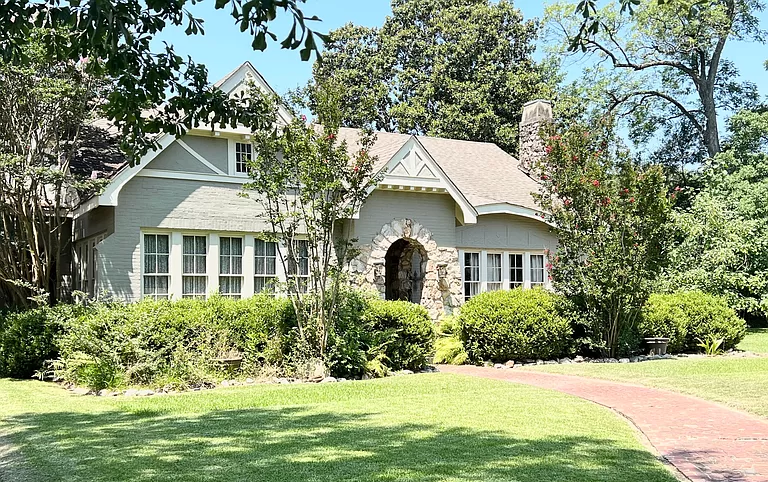Greenwood’s Grand Boulevard Historic District

The History of Greenwood, Mississippi
Greenwood is a city built on two rivers. The first river settlement was established in 1834 by John Williams, who purchased land along the south bank of the Yazoo River, which was made available when the Choctaw Indians moved west. Williams decided it was an ideal place for a town and a good shipping point for cotton. Shortly after that, Titus Howard and Samuel B. Marsh settled land on both sides of the Yazoo adjacent to Williams’ settlement. They divided the land on the south side of the river into lots, and before long, a town sprang up. Named for Greenwood Leflore, the last chief of the Choctaw Indians, the city was incorporated in 1844.
The town grew as the cotton business boomed, drawing cotton from miles around to be shipped out of Greenwood by truck and rail. However, the big business of cotton marketing was still situated in the larger cities on the Mississippi River. The Civil War brought the end of the cotton boom in Mississippi, but Reconstruction would bring new life to the wilderness town of Greenwood.
In the 1880s, Congress implemented a plan to construct a levee system to drain swamps and permit more cotton farming in the Delta. Once again, Greenwood became the shipping point for thousands of bales of cotton. The railroad came to town, streets were paved, and the cotton marketing business boomed as cotton offices appeared all along Front Street.
Greenwood was expanding in every direction except north of the Yazoo River, where Senator J. Z. George’s plantation was located. However, the turn of the century brought changes to Greenwood: a new courthouse, a grandiose Confederate Memorial, a new library, and soon a new residential subdivision between the Yazoo and Tallahatchie rivers on the site of George’s former plantation.
The Grand Boulevard Beginnings
Captain Sam Gwin, E. R. McShane and W. T. Loggins developed the plans for a boulevard that would span these two rivers. Gwin’s wife, Sally Humphreys Gwin, also had a hand in the development of Grand Boulevard, as she decided it would be lined entirely with large oak trees, not knowing how far-reaching that decision would be. She had servants transplant oak saplings from the banks of the Tallahatchie and directed their placement daily along the Boulevard. Soon, many of the large lots were purchased, and homes were built.
Constructed in the fashionable styles of their times, each house showcased the wealth, prosperity and respectability that had come to Greenwood. In the 1920s, it became apparent that a new bridge across the Yazoo was needed to replace the old 1894 drawbridge, and the Keesler Bridge was constructed. This steel swing bridge was built on concrete piers with wooden walkways lining either side. Keesler Bridge was designed to rotate on a center pier to create a passageway for river traffic and formally opened in 1925.
While the town of Greenwood escaped the devastation caused by the Mississippi River Flood of 1927, it was not entirely immune to the threats of the rivers. In 1932, the Tallahatchie River overflowed its banks and moved down Grand Boulevard to the Yazoo River. Most of the houses were built high enough to escape any real damage, but there was so much water that cars gave way to boats as the town constructed a wooden pier down the Boulevard.
Through the years, Grand Boulevard has remained Greenwood’s premier street and neighborhood. It truly reflects the prosperity of the city and its position as the center of Mississippi’s second cotton kingdom. While some of the lots have been subdivided, many are still several acres with beautifully landscaped yards. Between the Yazoo and Tallahatchie Rivers are Greenwood’s finest examples of homes in the Neo-classical Revival, Tudor, Spanish Eclectic and Prairie styles. And of course, there still remains the beauty and shade of the towering oaks planted long ago by Mrs. Gwin. Her ideas and work have brought joy to generations of citizens as they stroll through time along Grand Boulevard.
Grand Boulevard Historic Architectural Homes Tour
- 209 Grand Boulevard, at the corner of Grand Boulevard and President, is a wonderful example of the Tudor style. The house displays many typical elements of this style, such as the stuccoed exterior above brick wainscoting and the half-timbering in the gable ends. Several Craftsman influences can also be found in this home, including the low-pitched roof and brackets under the porte-cochere.
- 301 Grand Boulevard, constructed around 1915, is an excellent example of the Prairie style. This two-story, stuccoed home has the most common form of this architectural style, with its symmetrical facade, full-width front porch, large square porch supports and fairly low, hipped roof.
- Across the street, facing President Street sits a Colonial Revival house. This is the only home along Grand Boulevard which faces another street. This structure has a porch supported by Ionic columns and finely detailed geometric patterns in the dormer windows.
- Further down the Boulevard at the corner of Jefferson Street sits 319 Grand Boulevard, one of the most significant Neo-classical Revival houses in Greenwood. Designed by H.C. White of Tennessee and constructed in 1910, this home is individually listed on the National Register of Historic Places. Originally built for the Provine family, this house has a remarkable giant-order (two-story) portico with a balustraded flat roof, bracketed cornice and full entablature supported by fluted Ionic columns. Over the entrance is a smaller version of this same portico. This home was used in the filming of The Reivers.
- The next house on the west side of the Boulevard was constructed circa 1912 and exhibits elements of several different architectural styles. The brackets under the eaves are reminiscent of the Italianate style, while the monumental portico is representative of the Greek Revival. The house is similar to Malmaison, Greenwood Leflore’s home in Carroll County, which burned in 1942.
- The brick house at 413 Grand Boulevard was constructed circa 1920 and also had brackets under the eaves, as well as several classical details, including the Doric columns supporting the portico. This home was featured as Hilly Holbrook’s house in The Help movie.
- The frame house on the southeast corner of Grand Boulevard and Adams Street is designed in the Colonial Revival style, but the form is influenced by Queen Anne. This home was constructed around 1912 and possesses a wrap-around porch supported by Ionic columns, as well as the geometric patterns in the windows.
- 601 Grand Boulevard is another example of the Tudor style. Constructed around 1930, this house displays several cross-gables on the roof, a common characteristic of this style, with decorative half-timbering in the gable ends.
- 618 Grand Boulevard is the first example of a Bungalow on this tour. Constructed around 1920, this house represents the merging of the Arts & Crafts movement with prevailing Mississippi tastes. It has a centrally located entrance flanked by windows, all sheltered by an undercut porch. This characteristic is similar to a Planter’s Cottage — a common type of house in Mississippi — but details such as the low-pitched roof pierced by a long, low-pitched shed dormer are Craftsman style.
- 705 Grand Boulevard is a third example of the Tudor style popular during Grand Boulevard’s development. This house has the characteristic complicated cross-gabled roof with half-timbering in the gable ends and an arched entrance, also common to the style.
- 718 Grand Boulevard exhibits characteristics of the Colonial Revival style, with the pedimented entrance supported by paired Ionic columns. This house was constructed circa 1920 with a few later additions.
- At 810 Grand Boulevard is the house built by Captain Sam Gwin, the developer of Grand Boulevard. Gwin’s wife, Sally, was responsible for the canopy of oak trees that grace the Boulevard. The architect for this house was Frank R. McGeoy of Greenwood. This house still sits on its large lot, as many of the original houses along the Boulevard did at one time.
- 1012 Grand Boulevard is a remarkable Spanish eclectic structure. Constructed circa 1925, this stucco house displays a beautiful Spanish tile roof and an arcaded porch, as well as iron details for decoration, such as on the balconies. This home was used in the filming of a silent film.
- Constructed in 1927, 1102 Grand Boulevard represents one of the finest examples of the Tudor style in Greenwood. The house contains the characteristic arched entrance and porte-cochere and numerous steeply-pitched cross-gables on the roof. Also common to this style are the massive stone chimneys topped with decorative chimney pots.
- The Tudor outbuilding directly north, once the carriage house for 1102 Grand Boulevard, now serves as corporate housing for the Viking Range Company after an award-winning renovation was completed using the federal preservation tax credit.
- 1440 Grand Boulevard, overlooking the Tallahatchie River, is individually listed on the National Register of Historic Places. Constructed circa 1920, this Tudor house was designed by George Mahon of Memphis but with a different approach to the style than the other houses on the tour. The decorative half-timbering is more suggestive of the German approach than the English, and eyebrows shelter the entrance and upper-floor windows.
Back To Itineraries Page



